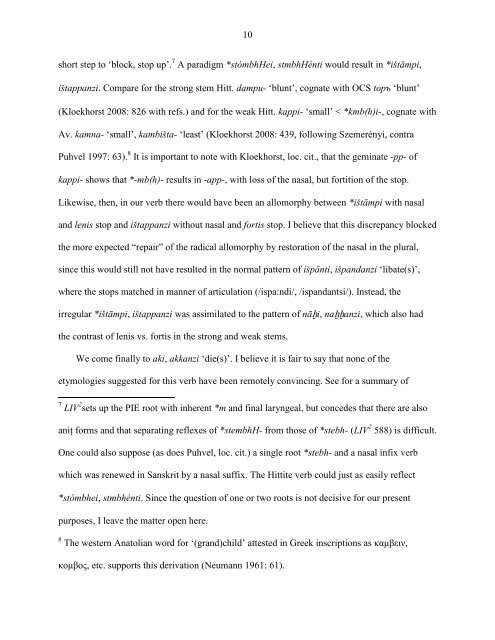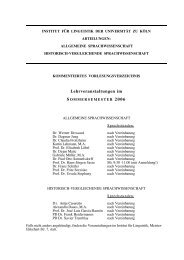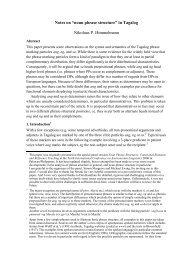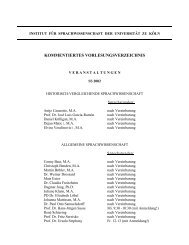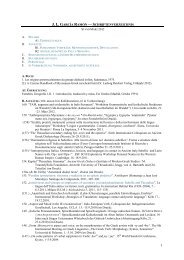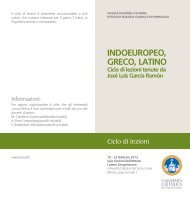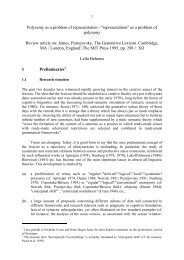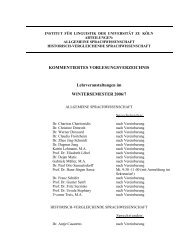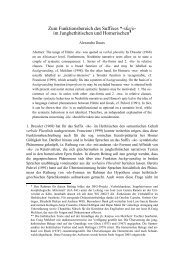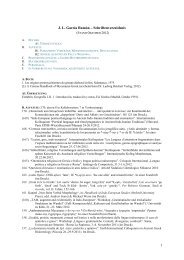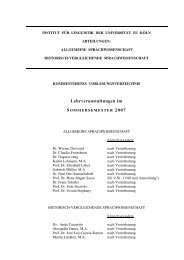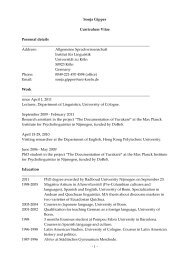Topics in Anatolian Historical Grammar Prof. Dr. H. Craig Melchert
Topics in Anatolian Historical Grammar Prof. Dr. H. Craig Melchert
Topics in Anatolian Historical Grammar Prof. Dr. H. Craig Melchert
You also want an ePaper? Increase the reach of your titles
YUMPU automatically turns print PDFs into web optimized ePapers that Google loves.
10<br />
short step to ‘block, stop up’. 7 A paradigm *stómbhHei, stmbhHénti would result <strong>in</strong> *ištāmpi,<br />
ištappanzi. Compare for the strong stem Hitt. dampu- ‘blunt’, cognate with OCS topъ ‘blunt’<br />
(Kloekhorst 2008: 826 with refs.) and for the weak Hitt. kappi- ‘small’ < *kmb(h)i-, cognate with<br />
Av. kamna- ‘small’, kambišta- ‘least’ (Kloekhorst 2008: 439, follow<strong>in</strong>g Szemerényi, contra<br />
Puhvel 1997: 63). 8 It is important to note with Kloekhorst, loc. cit., that the gem<strong>in</strong>ate -pp- of<br />
kappi- shows that *-mb(h)- results <strong>in</strong> -app-, with loss of the nasal, but fortition of the stop.<br />
Likewise, then, <strong>in</strong> our verb there would have been an allomorphy between *ištāmpi with nasal<br />
and lenis stop and ištappanzi without nasal and fortis stop. I believe that this discrepancy blocked<br />
the more expected “repair” of the radical allomorphy by restoration of the nasal <strong>in</strong> the plural,<br />
s<strong>in</strong>ce this would still not have resulted <strong>in</strong> the normal pattern of išpānti, išpandanzi ‘libate(s)’,<br />
where the stops matched <strong>in</strong> manner of articulation (/ispa:ndi/, /ispandantsi/). Instead, the<br />
irregular *ištāmpi, ištappanzi was assimilated to the pattern of nāḫi, naḫḫanzi, which also had<br />
the contrast of lenis vs. fortis <strong>in</strong> the strong and weak stems.<br />
We come f<strong>in</strong>ally to aki, akkanzi ‘die(s)’. I believe it is fair to say that none of the<br />
etymologies suggested for this verb have been remotely conv<strong>in</strong>c<strong>in</strong>g. See for a summary of<br />
7 LIV 2 sets up the PIE root with <strong>in</strong>herent *m and f<strong>in</strong>al laryngeal, but concedes that there are also<br />
aniṭ forms and that separat<strong>in</strong>g reflexes of *stembhH- from those of *stebh- (LIV 2 588) is difficult.<br />
One could also suppose (as does Puhvel, loc. cit.) a s<strong>in</strong>gle root *stebh- and a nasal <strong>in</strong>fix verb<br />
which was renewed <strong>in</strong> Sanskrit by a nasal suffix. The Hittite verb could just as easily reflect<br />
*stómbhei, stmbhénti. S<strong>in</strong>ce the question of one or two roots is not decisive for our present<br />
purposes, I leave the matter open here.<br />
8 The western <strong>Anatolian</strong> word for ‘(grand)child’ attested <strong>in</strong> Greek <strong>in</strong>scriptions as καμβειν,<br />
κομβος, etc. supports this derivation (Neumann 1961: 61).


